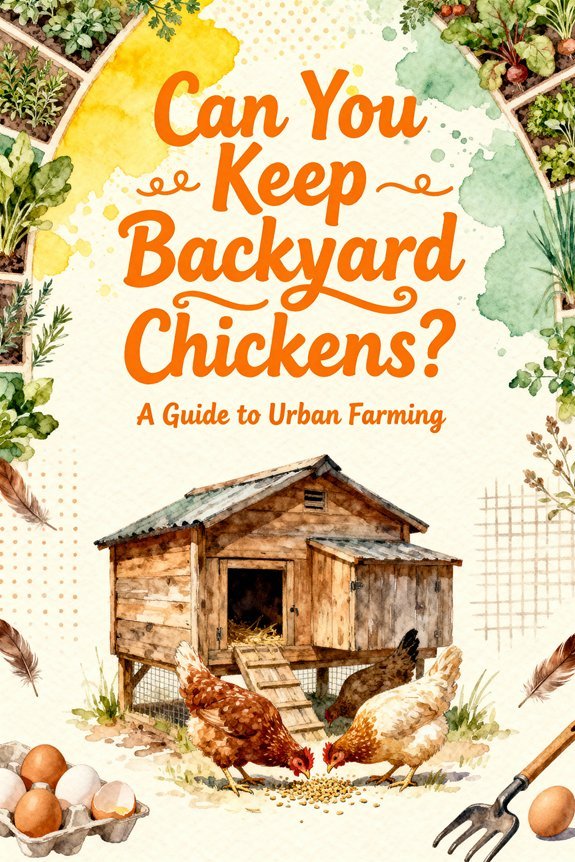Can You Keep Backyard Chickens? A Guide to Urban Farming
You can keep backyard chickens in most urban areas with proper permits, typically allowing 4-6 hens. You’ll need 2-4 square feet of coop space and 8-10 square feet of run space per bird, plus predator-proof housing with adequate ventilation. Choose quiet, docile breeds like Buff Orpingtons or Silkies for eggs and neighborly relations. Beyond fresh eggs, your flock will reduce food waste and provide valuable garden fertilizer. The key to success lies in understanding local regulations and essential care requirements.
Understanding Local Regulations and Permits
Before starting your backyard chicken journey, you’ll need to thoroughly research and comply with your local regulations, as requirements vary greatly across jurisdictions. Start by checking your property’s zoning laws through your city or county’s website to confirm whether chickens are permitted in your area.
Most residential zones allow 4-6 hens but restrict roosters. You’ll likely need to navigate permit processes, which typically cost around $50 and may require periodic renewal. If you’re renting or part of an HOA, you’ll need written permission to keep chickens. Pay close attention to setback requirements, which dictate minimum distances between coops and property lines, typically ranging from 20 to 200 feet. Remember that separate permits may be needed for coop construction, and specific design standards might apply. Regular health and safety inspections may be required by your local municipality to ensure compliance with sanitation standards. Some progressive cities now offer urban farming incentives to encourage responsible backyard chicken keeping. Maintaining proper coop ventilation standards is essential for both chicken health and neighborhood harmony.
Space Requirements for Urban Chicken Keeping
With your local permits secured, proper space planning becomes your next key consideration for urban chicken keeping. You’ll need to provide 2-4 square feet of coop floor space per chicken, with 3 square feet being ideal for standard breeds in urban settings. Each bird also requires 8-10 square feet of outdoor run space for essential activities like foraging and dust bathing. While smaller flocks work well in urban settings, a larger flock of 20 birds would need coop sizes ranging from 60 to 100 square feet. Medium-sized breeds typically need 12-16 square feet of indoor space for optimal comfort.
Inside the coop, allocate 12 inches of wooden roosting bar per chicken and one nest box for every 4-5 hens. To maximize limited urban space, consider multi-level coop designs or movable “chicken tractor” structures. If you’re working with tight space constraints, choose smaller breeds and incorporate vertical enrichments like hanging treats. Remember, providing more than minimum space requirements will promote better health and reduce potential behavioral issues. Proper ventilation holes should be installed near the roof to prevent harmful ammonia buildup from chicken droppings.
Essential Coop Design and Setup
A well-designed chicken coop serves as your flock’s primary defense against predators while guaranteeing ideal living conditions. Start with thorough predator proofing by using 1/2-inch hardware cloth on all sides, buried 12 inches deep to prevent digging. Install two-step latches on doors and consider elevating the coop for added security. Regular maintenance and disease prevention protocols are essential for keeping your flock healthy. Small breeds need 2 square feet of indoor space per bird while larger breeds require more.
Proper coop ventilation is vital – incorporate adjustable vents above roosting areas to maintain fresh air while preventing drafts. You’ll need roosting bars about 2 inches wide and one nesting box per 3-4 hens, positioned in a quiet area. Design the coop with easy-access doors for cleaning and egg collection, and choose materials that you can disinfect easily. Face your coop south or east for natural light, and guarantee the roof provides complete protection from weather elements. Plan for 10 square feet of space per bird if they will be permanently confined to the coop.
Choosing the Right Chicken Breeds
Selecting the perfect chicken breeds for your backyard flock requires careful consideration of your space constraints, local climate, and specific goals for egg production or meat yield.
For urban settings, consider docile breeds like Buff Orpingtons or Australorps, which adapt well to confinement while maintaining high egg production. These breeds offer excellent breed compatibility in small flocks. Silkies’ fluffy appearance makes them charming pets while still producing 100-120 eggs yearly. You’ll notice egg differences among varieties – Ameraucanas lay distinctive blue eggs, while Rhode Island Reds produce dark brown eggs.
If you’re working with limited space, bantam breeds can thrive in smaller coops. For dual-purpose benefits, Plymouth Rocks or Rhode Island Reds provide both consistent egg laying and meat potential. In suburban areas, quieter breeds like Ameraucanas help maintain good neighbor relations while delivering 200-250 eggs annually.
Daily Care and Maintenance Routines
Maintaining a healthy backyard flock requires consistent daily attention to essential care routines that promote chicken welfare and ideal egg production. Your feeding schedules should include dispensing fresh pelleted feed and scattering corn as an afternoon treat. Safeguard each bird has access to at least one liter of clean water, plus extra during hot weather. Use a hand brush to clean water containers thoroughly before refilling them.
Perform daily health checks by observing your flock’s behavior, looking for signs of lethargy or isolation. Collect eggs multiple times throughout the day to maintain freshness and prevent broodiness. Popular breeds like the Barred Rock can produce 200 brown eggs annually with proper care. Keep the coop environment clean by removing droppings, replacing soiled bedding, and maintaining proper ventilation. You’ll need to close the pop hole at dusk and open it at dawn to protect against predators while allowing fresh air circulation.
Health and Safety Considerations
While backyard chickens bring joy and fresh eggs to your homestead, they also carry significant health risks that require careful management. Disease prevention must focus on protecting both your family and flock from pathogens like Salmonella and Campylobacter, which chickens can carry without showing symptoms.
Your risk management strategy should include rigorous hand washing before and after handling birds, using dedicated clothing and footwear for coop maintenance, and avoiding close face contact with chickens. Keep your coop clean, promptly remove soiled bedding, and maintain proper biosecurity by preventing contact between your flock and wild birds. Proper coop cleanliness is crucial for consistent egg production and preventing stress-related health issues in your flock. For fungal infections like vent gleet, consult a veterinarian about using miconazole treatment on affected birds. If you have young children, elderly family members, or immunocompromised individuals in your household, take extra precautions as they’re more vulnerable to chicken-related illnesses. For urban chicken owners, it’s essential to test eggs regularly as lead contamination can occur in city environments.
Building Positive Neighbor Relations
Successful backyard chicken keeping hinges on fostering positive relationships with your neighbors. Start your neighbor outreach early by explaining your plans, addressing concerns, and sharing the benefits of urban chicken keeping. You’ll find most resistance stems from misconceptions about noise, odors, and pests – issues you can prevent through proper management.
Studies show hens are quieter than typical barking dogs, which can help reassure concerned neighbors about potential noise disruption. Maintain open communication and demonstrate your commitment to responsible chicken keeping. Share surplus eggs, offer coop tours, and respond promptly to any concerns for effective conflict resolution. Install proper fencing, keep your coop clean, and follow local ordinances to minimize disruption. Consider joining local urban farming groups to stay informed about best practices and community standards.
Benefits of Urban Chicken Farming
Beyond fostering good neighbor relations, backyard chickens offer remarkable benefits for urban sustainability and household well-being. You’ll help reduce landfill waste, as each hen can transform up to 83 pounds of food scraps annually into valuable eggs and fertilizer. This circular approach decreases methane emissions while providing natural pest control and soil aeration for your garden. Starting hens on proper feed timing around 16-20 weeks ensures successful egg production.
The nutritional advantages are significant, with fresh eggs delivering essential proteins and supporting better dietary diversity, especially in children. You’ll notice economic savings too, as your flock can produce enough eggs to meet your household’s yearly needs while reducing dependence on store-bought options. By choosing backyard chickens, you’re not just saving money – you’re contributing to a more sustainable food system by decreasing the demand for industrial egg production and transportation. The daily interaction with your chickens can provide mental health benefits, helping reduce anxiety and improve overall mood through routine care and connection. Proper nutrition management requires layer feed for mature hens to ensure optimal egg production and shell quality.
Managing Waste and Environmental Impact
Managing your backyard flock’s waste effectively transforms potential environmental hazards into valuable resources for your garden and community. Your chickens can consume about 1.6 pounds of kitchen scraps weekly, markedly reducing your household’s food waste while producing nutrient-rich eggs in return. Research shows that backyard chickens help create a circular economy system by converting household waste into usable products.
Proper waste management is essential for environmental sustainability. Each chicken produces 5-6 pounds of manure annually, which, when composted correctly, becomes an excellent fertilizer with twice the nitrogen and phosphorus content of other livestock manures. To maximize benefits while minimizing environmental impact, implement rotational grazing using chicken tractors and maintain proper composting practices.
You’ll want to avoid common pitfalls of mismanaged waste, such as nutrient runoff and soil degradation, by following systematic collection and composting protocols. This approach guarantees your urban farming efforts contribute positively to local sustainability goals.




